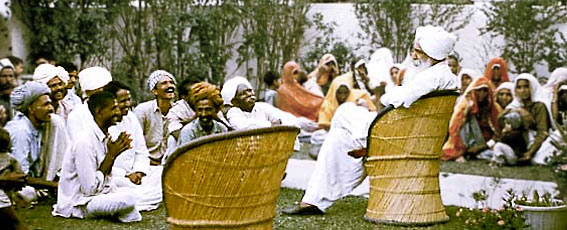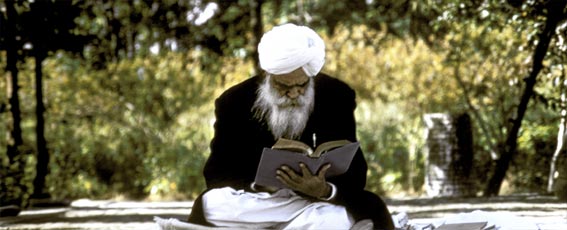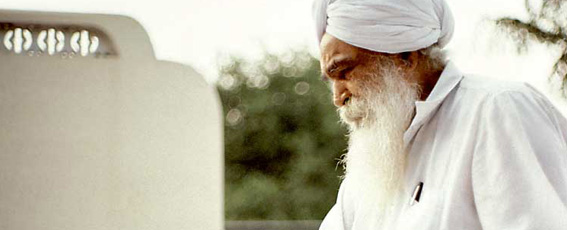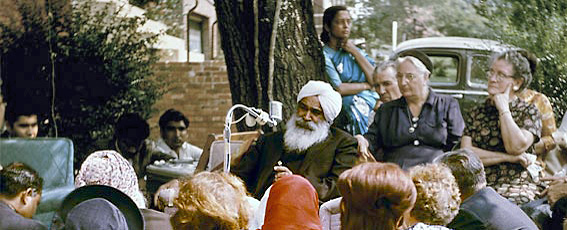From the book "The crown of life", written by Sant Kirpal Singh
The Sound Current undoubtedly offers the surest way to man for reaching from form to the Formless, but the question arises, how can man get access to It and thus accomplish his inner journey?
Those proficient in this path always maintain that there are three conditions that must be fulfilled before success in this truest of all yogas can be attained:
Satguru: The first condition is that of finding a Satguru or true teacher who is an adept in this mystic science. The subject is one of practical self-realization, not of philosophic dissertation or intuitive feeling. If it were one of mere theory, then books and scriptures would be enough for our purpose, and if it were one of mere feeling then each could trust the promptings of his own mind. But the question before us is that of unlocking a "sixth" sense, one of direct transcendental perception, of inner hearing and seeing. One born deaf and blind may, with the help of Braille, learn the most detailed expositions of man's rich and varied audio-visual experiences, but his study can never give him direct experience. The most that he can get from books is the realization of an extensive plane of experience wholly beyond him, and this can generate in him the urge to discover means whereby he can overcome his physical limitations. It is the expert surgeon or doctor who alone can effect a cure (provided his ailment is curable). And should he fall into the hands of a charlatan, his condition will only become worse and more complicated.
In like manner, the aspirant who seeks inner spiritual mastery must seek the aid of one who has already mastered the way. All his readings of scriptures, all his thinking, can at best lead to a single conclusion, provided he is sensitive to the point involved: the need for a living Master. Without such a Master he cannot even understand the true import of the revelatory scriptures. They speak of experiences beyond his level of experience, and even in his own language they can only speak in metaphors and parables, for how can the discourses of the blind be made to express directly that of the seeing? To attempt to interpret the rich spiritual heritage in our religious literature wholly in terms of our own limited experience might lead to a distortion of the true meaning. We might gather a great deal of psychological wisdom, but the inner significance would be lost on us, and all our intellectual theorizing would only land us in unending theological contradictions with which the various institutionalized religions are encumbered today.
Only one who has himself experienced what the great scriptures describe, can guide us to their real significance. But the task of a spiritual teacher does not end there. The elucidation of the true meaning of religion is no more than a first step. After the aspirant has understood the nature of his goal, he must pursue it practically and rationally. To know is one thing, and to do is quite another. It is only after he has explained to the aspirant the end to be attained that the Master's real task begins. It is not enough that the doctor diagnoses the cause of the blind man's ailment, he must perform the operation as well. So too the spiritual guide at the time of initiation gives the disciple a first-hand experience of the inner Light and Sound. He puts him into touch with the Divine Stream, be it at its lowest level, and instructs him in the sadhnas to be followed for consolidating and developing this inner experience to its full extent.
He who can find such a teacher is blessed indeed. But to discover such a one and be initiated by him is not enough. The germinal spiritual experience that he gives must be nurtured and developed to the point of full spiritual efflorescence. To be able to do this, one must accept whatever one learns and attempt to put it into practice. To know such a man is to love him, and to love him is to follow his commandments. Until one can thus love and obey, and so transform one's life, the gift of the Guru remains as a seed locked away in a steel vault where it cannot sprout and grow to fruition.
Sadachar: It is the necessity for self-discipline that makes sadachar the second cornerstone of the pattern. The word sadachar is not easy to translate. One can find many literal equivalents, but none of them really expresses its extensive and many-sided significance. In brief, it stands for the good and pure life. It does not imply any rigid code or set moral formulae, but suggests purity and simplicity, which radiate from within and spread outwards, permeating every action, every word, every thought. It is as much concerned with one's personal habits, good and hygienic, as with one's individual and social ethics. And on its ethical side, it is concerned not merely with one's relation to one's fellow men but to all living things, i.e., harmony which is the result of recognition that all things are from the same Essence, and so a worm is as much a part of Brahman as the mightiest of gods, Indra.
The first lesson taught by a true Guru is that of "the identity of substance," and he who has grasped this truth will discipline his life accordingly. He will not be a prey to inordinate desires, and his one aim will be to reach the still point which holds in itself all actions, the point where to have nothing is to possess everything. He will know that the one path to fulfilment is through renunciation, and the one way to reach the Almighty is through freeing himself from all other attachments:
In order to arrive at having pleasure in everything,
Desire to have pleasure in nothing.
In order to arrive at possessing everything,
Desire to possess nothing.
In order to arrive at being everything,
Desire to be nothing.
ST. JOHN OF THE CROSS
Cleanse the chamber of thy heart
That thy Beloved may enter.
TULSI SAHIB
Where there is nothing, there is God.
W. B. YEATS
Freed from the demon of desire (kama), he will be freed from the demon of wrath (krodh), which follows upon frustration of desire. Liberated from these, he would be freed also from greed (lobh), attachment (moh) and pride (ahankar), which are but the extensions of desire.
His would be a life of detachment or of nishkama. But detachment would not be for him a life of indifference or of ascetic renunciation. To know all life is to discover a new bond between oneself and the rest of creation. He who knows this cannot be merely "indifferent." He must perforce be filled to overflowing with sympathy for all that he confronts, and sympathy toward the whole must imply a certain holy indifference to the part. He will no longer be tied to his own narrow individual interests, but will share his love and resources with all. He will develop, slowly but surely, something of the compassion of the Buddha and the love of Christ. Nor will he feel himself called upon to leave the world for the solitude of the forest, the mountain or the desert cave. The detachment must be an inner one, and one who cannot achieve it at home will not achieve it in the forest. He will recognize the great use of occasional retreats from worldly affairs and cares to the silence of solitary meditation and concentration, but he will not seek to escape from life and its responsibilities. He will be a loving husband and a good father, but while being these he will never forget the ultimate purpose of life, always knowing how to give unto Caesar that which is Caesar's, and preserving for God that which is God's. The way for transcending desire, he will know, is not through repressing it but meeting it squarely and overcoming it. To him, sanyasa is not a matter of outer evasion or escapism but of inner freedom, an idea that is well expressed by Nanak thus:
Let contentment be your ear-rings,
And endeavour for the Divine and respect for the higher Self your wallet,
And constant meditation on Him your ashes,
Let preparedness for death be your cloak,
And let your body be like unto a chaste virgin.
Let your Master's teachings be your supporting staff.
JAP JI
The two cardinal virtues that such a man will cultivate will be charity and chastity. He will be large of heart and bounteous, caring more for the sufferings of others than for his own, and easily forgiving those that injure him. He will be simple and restrained in his habits. His wants will be few and easily satisfied, for one who has too many desires and too many attachments cannot be pure of heart. For him chastity will extend even to giving up meat and drink. When all life is one, to live upon the flesh of other living beings would be to defile oneself. And when one's goal is to attain even higher realms of consciousness, to resort to narcotics and intoxicants is only to court regression. It is not an idiosyncrasy of Indian seers that they should have made abstinence from meat and drink a necessary part of the spiritual discipline. We have similar injunctions in the Koran and the Holy Bible.
Thus in Proverbs 23:20, we find:
Be not among wine bibbers; among riotous eaters of flesh.
And in Romans 14:21:
It is good neither to eat flesh, nor to drink wine, nor anything whereby thy brother stumbleth, or is offended, or is made weak.
And in I Corinthians 6:13:
Meats for the belly, and belly for meats; but God shall destroy both it and them. Now the body is not for fornication but for the Lord; and the Lord for the body.
In the Essene Gospel of John (direct translation from the Aramaic of the pure original words of Jesus), we have:
But they answered Him: "Whither should we go, Master, . . . for with you are the words of eternal life. Tell us, what are the sins we must shun, that we may nevermore see disease?"
Jesus answered: "Be it so according to your faith," and He sat down among them saying:
"It was said to them of olden time, ‘Honor thy Heavenly Father and thy Earthly Mother, and their commandments, that thy days may be long upon earth.' And next was given this commandment: ‘Thou shalt not kill,' for life is given to all by God, and that which God has given, let not man take away. For I tell you truly, from one Mother proceeds all that lives upon the earth. Therefore he who kills, kills his brother. And from him will the Earthly Mother turn away, and will pluck from him her quickening breasts. And he will be shunned by her angels, and Satan will have his dwelling in his body. And the flesh of slain beasts in his body will become his own tomb. For I tell you truly, he who kills, kills himself, and whosoever eats the flesh of slain beasts, eats of the body of death. And their death will become his death. For the wages of sin is death. Kill not, neither eat the flesh of your innocent prey, lest you become the slaves of Satan. For that is the path of sufferings, and it leads unto death. But do the Will of God, that his angels may serve you on the way of life. Obey, therefore, the words of God: ‘Behold, I have given you every herb, bearing seed, which is upon the face of all the earth, and every tree, in which is the fruit of a tree yielding seed; to you it shall be for meat. And to every beast of the earth, and to every fowl of the air, and to everything that creepeth upon the earth wherein there is breath of life, I give every green herb for meat.' Also the milk of everything that moveth and that liveth upon each shall be meat for you; even as the green herb have I given unto them, so I give their milk unto you. But flesh, and the blood which quickens it, shall ye not eat." And Jesus continued: "God commanded your forefathers, ‘Thou shalt not kill.' But their heart was hardened and they killed. Then Moses desired that at least they should not kill men, and he suffered them to kill beasts. And then the heart of your forefathers was hardened yet more, and they killed men and beasts likewise. But I say to you: Kill neither men, nor beasts, nor yet the food which goes into your mouth. For if you eat living food the same will quicken you, but if you kill your food, the dead food will kill you also. For life comes only from life, and from death comes always death. For everything which kills your foods, kills your bodies also. And everything which kills your bodies, kills your souls also. And your bodies become what your foods are, even as your spirits, likewise, become what,your thoughts are."
With the chastity in food and drink will go another kind of chastity, the one that pertains to sex. One will not suppress all sexual desire, for repression can only breed neurosis and prepare the way for a downfall, but he will be ever seeking to sublimate it. He will understand that nature's purpose in this instinct is to preserve the race and will channel it so as to fulfill that purpose, never making it an end in itself, a source of physical pleasure, for when it becomes that, it turns into a drug that anaesthetizes the spirit and begins to defeat nature's purpose of procreation by encouraging the invention and use of contraceptives.
In short, the sincere and conscientious aspirant will reorient his entire mode of life, in eating and drinking, thinking, acting, feeling, etc. He will gradually weed out of his mind all irrelevant and unhealthy desires, until he gradually attains the state of purity and simplicity that marks the child.
Verily I say unto you, except ye be converted and become as little children,
ye shall not enter into the Kingdom of God.
ST. MATTHEW
All religious teachers the world over, laid great stress on higher moral values, and these in fact, constitute the groundwork for their teachings. A true Master always insists on the maintaining of a record of daily lapses in thought, word and deed, from non-injury, truth, chastity, universal love and selfless service of all, the five cardinal virtues that pave the way for spirituality. It is only the knowledge of our faults that can make us weed them out and strive in the right direction.
Through all this process of reintegration, his inspiration will be the example of his Master and the inner experience he gives. His Master's life will be a living testament beckoning him toward the ideal of sadachar, and the experience he has of the Word within will stand as a proof of the truth of what his Master teaches. Sadachar is no dry discipline that can be attained by following certain set formulae.It is a way of life, and in such matters only heart to heart can speak. It is this that makes Satsang, or association with a true Master, so important. It not only serves as a constant reminder of the goal before the seeker, but through the magic touch of personal contact, gradually transforms his entire mode of thinking and feeling. As his heart and mind under this benign influence grow gradually purer, his life more fully centres in the divine. In short, as he increasingly realizes in practice the ideal of sadachar, his thoughts, now scattered and dissipated, will gain equipoise and integration till they arrive at so fine a focus that the veils of inner darkness are burnt to cinders and the inner glory stands revealed.
Sadhna: And now we come to the third cornerstone of the spiritual edifice, that of spiritual sadhna or discipline. The one recurrent theme of a puran guru or perfect teacher, is that the good life, though highly desirable and indispensable, is not an end in itself. The goal of life is something inner and different. It is an ascension from the plane of relativity and physical existence into one of Absolute Being. He who recognizes this will mould his life accordingly, first, because such a recognition implies a state of mind that, being free from ego and attachment, expresses itself in virtuous and creative action, and second, because without cultivating such a state of mind and of life one cannot attain the poise and concentration required for inner ascension.
So the basic stress of the enlightened teacher is laid always upon the transcendental goal. He teaches that the pranic and vigyanic energies are not of the essence of Atman, but take their birth in planes lower than those of pure spirit. He who would use them as a ladder may transcend bodily consciousness, may reach the planes whence they originate, but he cannot reach beyond. The spirit being similar in all, the means to spiritual enlightenment should likewise be accessible to all. But, as has been seen already, such forms of yoga as are based on the pranas or on jnana make special demands which all cannot fulfil. The pranic systems are beyond the reach of the old or those of tender years, and also of those who suffer from any respiratory or digestive disorders. The path of Jnana presumes mental and intellectual capacities that Nature bestows only on few. If these approaches were indeed the natural ones open to us, then the logical conclusion would be that Nature is very partial in her blessings, discriminating between man and man. Why, if the sun shines for all, and the wind blows for all, should the inner treasures be available only to the chosen few? They are also for the learned and the unlearned.
Yogas that are so discriminating in selecting their practitioners, and so exacting in their practice, cannot be wholly natural. The method taught by the Masters of the Surat Shabd Yoga is different. As mentioned earlier, the nature of creation and the way back to life's initial source is explained to the seeker. At the time of initiation, he is given a first-hand inner experience which he is taught to develop. The seat of the soul is between and behind the eyebrows. This at least is accepted by all yogas. It is to this point that mystics refer when they speak of shiv netra, divya chakshu, tisra til, Brahmrendra, triambka, trilochana, nukta-i-sweda, koh-i-toor, third eye, single eye, figuratively called the still point, the mount of transfiguration, etc. It is at this point that the sadhak having closed his eyes must focus his attention, but the effort at concentration must be an effortless one and there must be no question of any physical or mental strain. To assist this effort the teacher gives the disciple a mantra, or charged verbal formula, which is symbolic of the journey ahead. This formula, when repeated slowly and lovingly with the tongue of thought, helps the disciple to collect his scattered thoughts gradually at a single point. What gives this mantra its potency is not any magic inherent in the words per se, but the fact that it is given by one who, by his own spiritual practice and mastery, has charged it with inner power. When the aspirant, by his inner concentration and by the mental repetition of the charged words, has brought his inward gaze to a sharp and steady focus, he will find that the darkness within that he at first confronted, gets gradually illuminated by shifting points of light. As his powers of concentration increase, the lights cease flickering and develop into a single radiating point.
This process of concentration, or the collection of surat, automatically draws the spirit-currents, normally dissipated all over the body, toward the spiritual centre. This withdrawal is greatly assisted by simran or repetition of the charged mantra; and the perception of the inner light, leading to dhyan or one-pointed concentration, quickens the process still further. In turn, dhyan when fully developed, leads to bhajan or inner hearing. The inner light begins to become resonant.
Within thee is Light and within the Light the Sound,
and the same shall keep thee attached to the True One.
GURBANI
The practitioner, when he shuts his physical ears, gets rapidly absorbed into the music. It is a common experience that though light can catch the eye, it cannot hold it for very long and has no very magnetic quality about it. But with music it is different. He who hears it in silence and stillness, is drawn irresistibly, as it were, into another world, a different realm of experience. And so the process of withdrawal that begins with simran, is stimulated by dhyan, and is rapidly extended by bhajan. The spiritual currents, already moving slowly, are carried upward, collecting finally at the third eye-the seat of the soul. The spiritual transcending of physical consciousness, or death in life, is thus achieved with the minimum of effort and travail.
When students of the other forms of yoga reach the state of full physical transcendence after a long and exacting mastery of the lower chakras, they generally assume that they have reached their journey's end. The inner plane at which they find themselves - the realm of Sahasrar or Sahasdal Kamal, often symbolised by the sun-wheel, the lotus or the multi-foliate rose – is indeed incomparably more beautiful than anything on earth, and in comparison appears timeless. But when the student of the Surat Shabd Yoga succeeds in rising above physical consciousness, he finds the Radiant Form of his Master waiting unsought to receive him. Indeed, it is at this point that the real Guru-shishya or teacher-student relationship is established. Up to this stage, the Guru had been little more than a human teacher, but now he is seen as the divine guide or Gurudev, who shows the inner way:
The feet of my Master have been manifested in my forehead,
And all my wanderings and tribulations have ended.
GURU ARJAN
With the appearance of the Radiant Form of the Master within,
No secret remains hidden in the womb of time.
Christ also speaks in the same strain:
There is nothing covered, that shall not be revealed, and hid, that shall not be known.
ST. MATTHEW
Under the guidance of this Celestial Guide the soul learns to overcome the first shock of joy, and realizes that its goal lies still far ahead. Accompanied by the Radiant Form and drawn by the Audible Life Current, it traverses from region to region, from plane to plane, dropping off kosha after kosha, until at last it stands wholly divested of all that is not of its nature. Thus disentangled and purified it can at last enter the realm where it sees that it is of the same essence as the Supreme Being, that the Master in His Radiant Form and the soul are not separate but One, and that there is naught but the Great Ocean of Consciousness, of Love, of Bliss ineffable. Who shall describe the splendour of this realm?
Only heart to heart can speak of the bliss of mystic knowers:
No messenger can tell it and no missive bear it.
HAFIZ
When the pen set to picturing this station,
It broke in pieces and the page was torn.
PERSIAN MYSTIC
Having reached the journey's end, the seeker too merges with the Word and enters the company of the Free Ones. He may continue to live like other men in this world of human beings, but his spirit knows no limitations and is as infinite as God Himself. The wheel of transmigration can no longer affect him, and his consciousness knows no restrictions. Like his Master before him, he has become a Conscious Co-worker of the Divine Plan. He does nothing for himself but works in God's name. If there be indeed any Neh-Karmi (one free from the bonds of action), it is he, for there is no more potent means to freedom than the Power of the Word.
He alone is action-free who communes with the Word.
GURBANI
Freedom for him is not something that comes after death (videh mukti); it is something achieved in life itself. He is a jivan-mukta (free-in-life); like a flower shedding fragrance, he spreads the message of freedom wherever he goes.
Those who have communed with the Word, their toils shall end.
And their faces shall flame with glory. Not only shall they have salvation,
Oh Nanak, but many more shall find freedom with them.
JAP JI
In actual practice of the spiritual discipline, stress is laid on Simran, Dhyan and Bhajan, each of which plays a specific role in unfoldment of the Self. The Master gives Simran or mental repetition of the charged words, which help in gathering together the wandering wits of the practitioner to the still point of the soul between and behind the two eyebrows, to which place the sensory currents now pervading from top to toe are withdrawn, and one becomes lost to the consciousness of the flesh. The successful completion of this process of itself leads to dhyan or concentration. Dhyan is derived from the Sanskrit root dhi, meaning "to bind" and "to hold on." With the inner eye opened, the aspirant now sees shimmering streaks of heaven's light within him and this keeps his attention anchored.Gradually, the light grows steady in his sadhna, for it works as a sheetanchor for the soul. Dhyan or concentration when perfected, leads one to Bhajan or attuning to the music which emerges from within the centre of the holy light. This enchanting holy melody has a magnetic pull which is irresistible, and the soul cannot but follow it to the spiritual source from whence the music emerges. The soul is helped by this triple process to slide out of the shackles of the body and becomes anchored in the heavenly radiance of its Self (atman), and is led on to the heavenly home of the Father.
The entire process is nurtured by Sat Naam, Satguru and Satsang, which in fact are synonymous for the Master Power at work.
Sat Naam is the Power of the Absolute stirred into compassion and when It puts on the flesh, It assumes the form of the Guru (Word made flesh), and works through him by means of Satsang, both outer and inner, which helps the jivas ripe for regeneration. This Power works on all the planes simultaneously, according to the needs of each individual; by word of mouth as a Guru in human form, sharing in all joys and sorrows of the human beings; by inner guidance as Gurudeva in his astral, luminous or radiant form, and finally as Satguru – a veritable Master of Truth.
There are two ways within: jyoti marg and sruti marg (the way of light and the way of sound), respectively. The holy Light keeps the soul anchored and absorbed and to a certain extent leads the soul as well, but the holy Word pulls it upward and carries it across from plane to plane in spite of various hurdles on the way, like blinding or bewildering lights, densely pitch darkness, etc., until the soul reaches its destination.

















